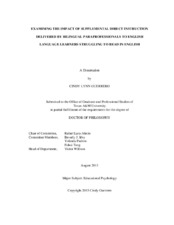| dc.description.abstract | English language learners, one of the fastest growing groups of students in public schools, continue to score lower in reading achievement when compared to non-English language learners. Struggling readers who do not receive early intervention are at-risk for reading failure and often continue to struggle with reading and academics. This small-n, quasi-experimental, longitudinal study (n=20) explored the differences in English reading between two closely matched groups of elementary Spanish-speaking ELLS, identified as struggling English readers, representing both structured English immersion and transitional bilingual programs. Treatment students received two years of supplemental English direct reading instruction provided by highly-trained bilingual paraprofessionals during Grades 2 and 3. Control students received standard district-based ESL instruction. This study derived from a randomized, longitudinal, federally funded research project (Project ELLA, #R305P030032) targeting native Spanish-speaking ELLs from low-SES backgrounds in a large urban school district in Southeast Texas.
Scores for English oral reading fluency and broad reading ability were used to compare growth over time and to compare students across conditions using descriptive statistics and repeated measures mixed analysis of variance (ANOVA). Students demonstrated statistically significant gains over time in both English oral reading and English road reading ability. However, there were no significant differences in oral reading fluency or broad reading ability between conditions at the end of Grade 3. Additional exploratory analyses further examined bilingual program within the treatment group. Treatment students demonstrated similar growth in English oral reading fluency, across both bilingual programs. In English broad reading ability, transitional bilingual treatment students outperformed structured English immersion treatment students.
The findings of this study expand the work of previous researchers in the area of supplemental direct English reading instruction of Grade 1 Spanish-speaking ELLs. The study adds to research that has not yet reported longitudinal L2 oral reading fluency and L2 broad reading findings for ELLs in Grades 2 and 3 who are struggling to learn to read in English. This study also contributes to limited studies investigating the effectiveness of bilingual paraprofessionals as tutors. | en |


